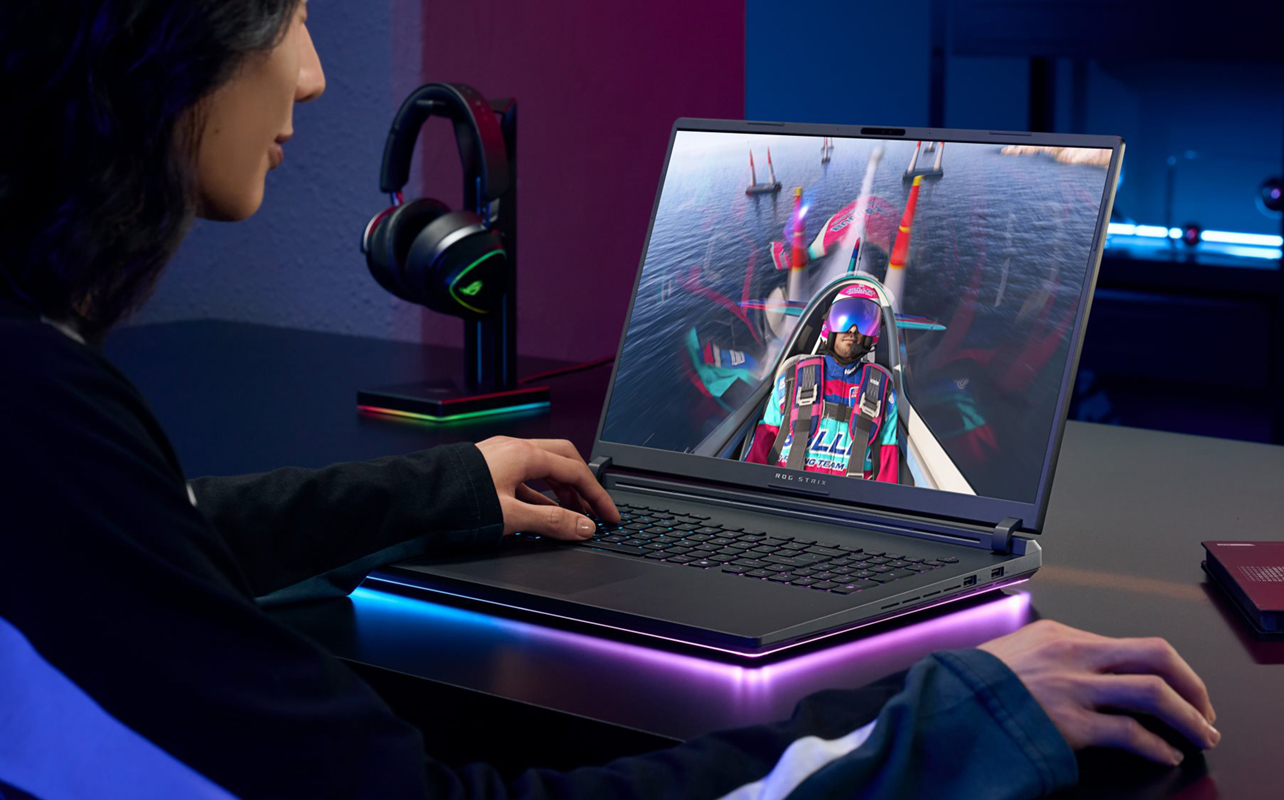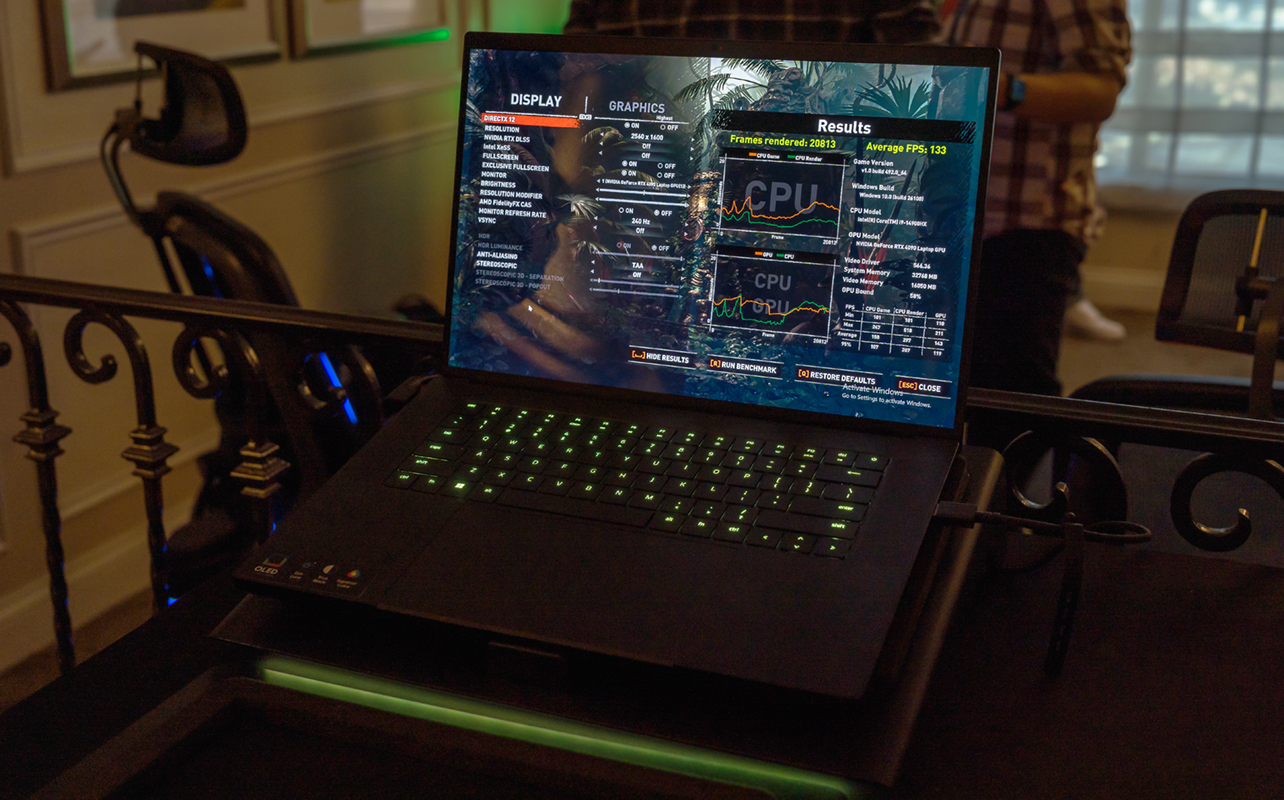
When you’re looking to pick the right gaming laptop, there are so many models, specs, and price points that it’s easy to get lost in the technical jargon. Once you know which features really matter, you’ll feel confident choosing the right one for your needs.
This gaming laptop buying guide will walk you through the most important specs—from GPU and RAM to storage, display, and cooling—so you can balance performance, portability, and price.
GPU (graphics card) is your #1 gaming priority
The GPU is basically the engine that powers frame rates, resolution, and the visual detail in your games. Simply put, your GPU has the biggest impact on how smoothly your games run and how good they look.
Here’s a quick breakdown:
- Entry-level (NVIDIA RTX 3050, GTX 1650) – Great for casual or indie games, esports titles like Fortnite or League of Legends, and gamers on a budget.
- Mid-range (RTX 3060–3070, RTX 4060) – A solid sweet spot for 1080p or QHD gaming. Delivers high frame rates in most modern titles.
- High-end (RTX 3080–4090) – The go-to choice if you want to play AAA games at 1440p or 4K with ray tracing enabled, or if you’re future-proofing your setup.
Tip: More than any other spec, the GPU will drive up the price. Decide upfront how much graphical performance you really need based on the games you play.
CPU (processor) – don’t overlook it
The GPU stands out for the above reasons, while the CPU plays an essential role in enabling games to run better. This is especially true of open-world games, strategy titles, or simulations that require heavy processing power because there are more expansive environments and variables onscreen. It’s also critical if you plan to stream or multitask while gaming.
- Intel Core i5/i7/i9 – Popular choices for gaming, with i7 and i9 models better for demanding workloads like video editing.
- AMD Ryzen 5/7/9 – Known for strong multi-core performance, making them excellent for both gaming and content creation.
If you’re only gaming, a mid-tier CPU paired with a solid GPU often offers the best balance. But if you’ll also be editing, streaming, or running CPU-heavy programs, go for an i7/i9 or Ryzen 7/9.
RAM – how much is enough?
In 2025, 16GB of RAM for gaming is the new baseline standard, ensuring smooth gameplay in most modern titles.
- 16GB – Ideal for most gamers.
- 32GB – Recommended for more intense gaming, as well as heavy multitasking, streaming, or running creative software.
Also check if the laptop allows RAM upgrades. That way, you can start with 16GB and add more later as your needs grow. Some gaming laptops don’t make this possible, though you’ll often find this is an option whereas it’s not on other non-gaming laptops.
Storage – speed + space
It’s really no contest when comparing SSD vs HDD gaming laptops: SSD is the way to go because it delivers dramatically faster boot and load times compared to older hard drives.
- NVMe SSDs – Even faster than traditional SATA SSDs, giving you near-instant game loads.
- Recommended storage sizes:
- 512GB SSD – Works if you mainly play a few titles at a time.
- 1TB SSD or higher – Better for larger AAA game libraries or if you store video projects, media files, or mods. Some of the biggest game titles are massive in file size nowadays, so you may have to keep that in mind if you’re looking to store a library of your own.
Optional: you can always add external storage or rely on cloud gaming services for extra flexibility.
Display – the gaming experience multiplier
A laptop’s display shapes your overall experience as much as the internals. Here’s what to look for:
- Size – 15.6-inch panels are the standard, balancing portability and immersion. Go 17-inch if you want a bigger, more cinematic feel.
- Resolution – Full HD is enough for most gamers; QHD is sharper and increasingly popular; 4K looks amazing but can be overkill unless paired with a very high-end GPU.
- Refresh rate – For smooth visuals, look for high refresh rate laptops with at least 120Hz or 144Hz. Competitive players may want 240Hz or more.
- Response time and sync tech – Lower response times reduce motion blur, while G-Sync or FreeSync tech helps eliminate screen tearing.
Cooling system – performance over time
Even the most powerful specs won’t help if your laptop overheats. A gaming laptop with a good cooling system ensures consistent performance and prevents thermal throttling (where your system slows down to manage heat).
Look for:
- Dual-fan setups
- Advanced designs like vapor chamber cooling
- Bottom and side venting for airflow
Tip: A strong cooling system will extend the life of your laptop and keep it comfortable during long gaming sessions. For a little help, some gamers also use cooling pads if fan noise or heat becomes noticeable.

Build quality and portability
Gaming laptops range from sleek, portable machines to bulky performance beasts. Here are points to consider:
- Chassis material – Metal builds feel premium and offer more durability.
- Weight – Some gaming laptops weigh 5+ pounds, so think about portability if you plan on carrying it around often.
- Keyboard – Look for comfortable key travel, customizable RGB lighting, and a layout that suits long gaming or typing sessions.
- Ports – HDMI for external displays, USB-C for modern peripherals, Ethernet for stable online play, and even an SD card reader if you dabble in creative work.
Battery life – manage expectations
The fact is even the best gaming laptop specs can’t defy physics. Gaming laptops rarely, if ever, offer all-day battery life, especially while running demanding titles. That means you should expect:
- Around 4–6 hours for mixed use (web browsing, light work).
- Less when gaming on battery—most laptops perform best when plugged in.
Some newer models support hybrid GPU switching, which lets the system run on integrated graphics for everyday tasks to extend battery life.
Price vs performance – budget breakdown
Gaming laptops come in all shapes, sizes, and budgets. Here’s a quick gaming laptop buying guide by price tier:
- Entry-level (–$1,000 CAD) – RTX 3050 GPU, Intel i5 or Ryzen 5, 8–16GB RAM. Best for casual gamers or students.
- Mid-range (–$1,500–$2,000 CAD) – RTX 3060–4060, Intel i7 or Ryzen 7, 16GB RAM. Perfect for most players who want high frame rates at 1080p/QHD.
- High-end ($2,000+ CAD) – RTX 4080–4090, 32GB RAM, QHD or 4K display, advanced cooling. Tailored for enthusiasts and professionals who want cutting-edge performance.
Rule of thumb: Prioritize GPU > CPU > RAM > Display (in that order) when allocating your budget.
Other considerations
Beyond the core specs, keep these points in mind:
- Upgradeability – Can you add RAM or storage later? This can stretch your laptop’s lifespan.
- Brand ecosystems – Popular gaming laptop lines like Razer Blade, Lenovo Legion, ASUS ROG, MSI, and Alienware offer different strengths.
- Software experience – Some laptops ship with pre-installed bloatware. A cleaner setup is always better.
- Warranty and support – A solid warranty gives you peace of mind if something goes wrong.
Level up with the right laptop
At the end of the day, the “best” gaming laptop depends on your needs and what you’re chasing. Is it ultra-high frame rates? Then you’ll want a balanced mix of performance and portability. Or do you just need a reliable machine for casual gaming? Focusing on the right specs will make all the difference.
Ready to start shopping? Explore all gaming laptops at Best Buy Canada and find the perfect fit for your playstyle, budget, and future gaming plans.





